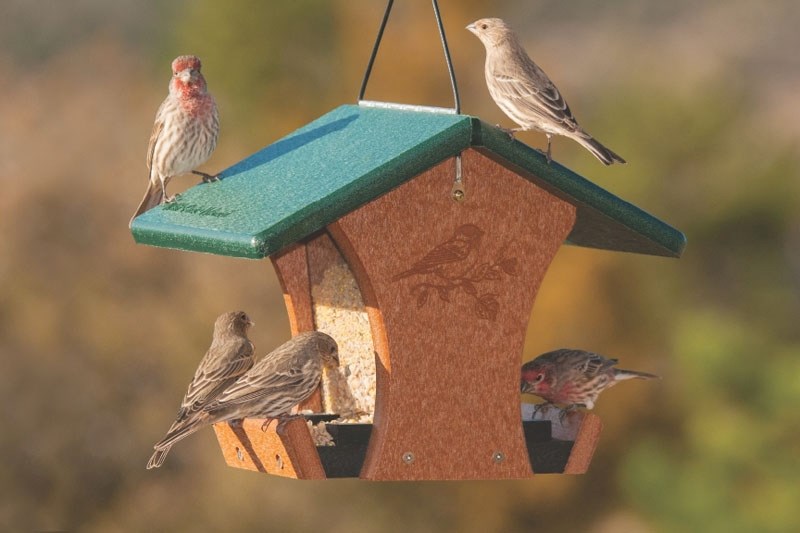Once the yard and garden is cleared of leaves, the shrubs covered and tree branches pruned, homeowners and gardeners can feel a bit blue. But, as many know, there’s plenty of life in the yard for those who take up bird feeding, a low cost and enjoyable pastime that can bring an abundance of chirping feathered friends to the yard all year long.
“We think it’s a very worthwhile hobby. If you miss the sound of birds, or miss the connection with nature, bird feeding can bring it back,” said David Cleary, who with wife Janis Chapman owns the popular Wild Birds Unlimited Nature Shop (about 15 minutes south of St. Albert at 12204-107 Ave N.W.)
Cleary said he gets many customers from St. Albert and Sturgeon County, where birds find abundant habitat of ravines, water source and trees. The 1,500 square-foot shop offers all the supplies – food, bird houses, bird baths, and feeders – that a hobbyist could want.
“One customer has photos of 60 different species of birds in his yard, and we’ve had reports of cardinals (usually an eastern bird) in Sherwood Park. You can make the bird feeding as time consuming and in-depth as you want, with different types of feed and feeders to attract different types of birds,” Cleary said. “But it can also be as simple as putting a bit of food out on a balcony, so it can be a hobby for apartment and condo dwellers too.”
Cleary said the benefits of bird feeding go beyond watching birds out the window, or hearing them sing. It is a service to the birds, who spend the fall and winter months looking for food. “That’s their work. They hunt for food and watch where other birds fly. And once they find a feeder they like, they do remember,” he said, pointing to the challenges year-round birds face in central Alberta. The extreme weather can mean losing about 10 per cent of their body weight overnight. They expend even more in energy constantly searching for food.
While hummingbirds and other species have flown to warmer climes, many birds stick around St. Albert and Sturgeon County all year long, where water (though frozen as ice and snow) and trees for nesting, shelter and insects are abundant. Among the birds who stay for all seasons are chickadees, finches, red and white-breasted nuthatches, house sparrows, downy woodpeckers, blue jays and magpies. They must dodge predators like cats and hawks.
While some birds favour insects, many species like one or a combination of seeds, suet and nuts. Some favour crab apples or berries, which ferment on the ground, making for some drunk birds come spring thaw.
At Wild Birds Unlimited, Cleary offers a wide variety of food and feeders, such as a hopper-type feeder where seed flows down into a tray. Tube-style feeders, about 18 inches long and three inches around, are made of sturdy recycled plastic with perches and holes coming out the sides of the tube.
“You can hang feeders on tree branches, balcony plant hooks or trellises – even on the clothes line,” said Cleary. The shop’s ‘flying start’ feeder is a $25 simple pin-style feeder with a long hook to thread on the food pucks. The compressed cakes of seed, suet (rendered beef fat) and nuts appeals to nuthatches and chickadees, among others, and are a great starter kit for those new to the hobby, Cleary said.
“You’ll see what is attracted to your yard with these feeders, and you can then add other feeders – even bird houses and baths.”
Cleary said birds love heated bird baths (often good to minus 10) to bathe in and drink (they’ll also eat snow for hydration). Birds appreciate bird houses too, where they often huddle together overnight to share heat. Don’t be surprised to see chickadees burrowing into the snow to create an igloo-type shelter, though.
“People of every age love helping birds out through the winter – grandparents and grandkids share the hobby – but it can be a year-round effort, if you want it to be. In the spring, birds appreciate the easy-access food while they’re creating nests and laying eggs. And in the fall, extra protein and calcium is needed while birds are moulting,” Cleary said.
Hole’s Greenhouses and Gardens likewise carries a variety of bird feeders and feed, including a black oil hull-less sunflower seed from Saskatchewan, which creates that quick energy for birds working to maintain their weight and body heat. “It’s a natural tie-in with gardening. People like to see life in their yard, year-round,” said Hole’s co-owner Jim Hole.
“And it’s a lot cheaper than golf,” laughed Cleary.
Birdseed tips for backyard birds
The Audubon Society offers tips for backyard bird feeding:<br />• Locate bird feeders at different levels<br />• Offer a variety of seeds in separate feeders<br />• Provide suet during cool weather months only. Peanut butter is a good all-season substitute for suet: mix one-part peanut butter with five parts corn meal and stuff the mixture into holes drilled into a hanging log, or slathered into the crevices of a large pine cone.<br />• Sparrows usually feed on the ground, while finches feed in shrubs. Chickadees and woodpeckers feed in trees.




